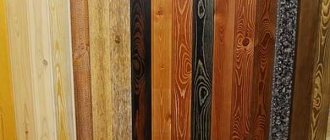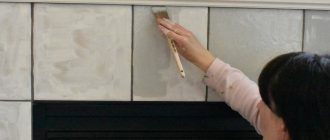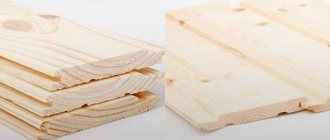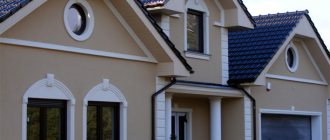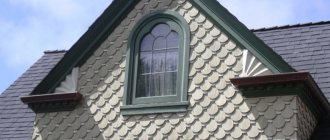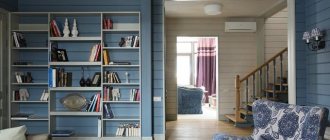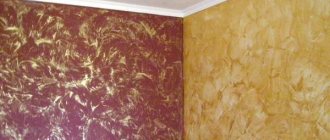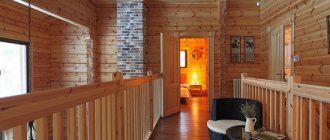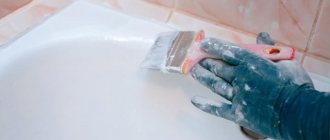Lining is a fairly common material today; designers use it to decorate interiors in Country style or in a marine theme. This material is durable and not expensive, but there is one drawback: over time, the lining requires updating, since due to temperature changes, humidity or abundant sun, stains appear on the wood and the material darkens. Let's look at ways to update the lining yourself.
Open with varnish
Varnishing is a common and easy-to-use method of updating lining. Buying varnish that will last a long time is not difficult. Manufacturers of varnishes improve their properties by adding antiseptics to the composition, which prevent the formation of mold.
For interior work, it is recommended to use aqualacs; they are easy to apply, preserve the structure of the wood and allow steam to pass through.
For exterior work, it is better to use alkyd-urethane varnish; it is more durable and resistant to ultraviolet radiation and moisture.
Before varnishing old wood, its wear is assessed. If the lining has not darkened and there are no obvious signs of damage, then it is enough to wash the surface with a soda solution and you can varnish. If stains appear on the wood, or the entire surface has darkened, then the old varnish is cleaned with sandpaper, after which it is also washed with soda and only then is the varnish opened.
Renewing old sheathed walls
There are several ways to update:
- Paint it.
- Plaster with sandpaper, then cover with acrylic.
- Paint with varnish.
Varnishing is the most common processing method. Wood is often used in construction, so polishing is a natural way to make your home look beautiful and extend its life. The varnish coating improves the condition of the entire finishing material.
Before you start painting, you need to determine the concept of the interior and its color.
Darkened pine paneling is initially coated with an antiseptic and then with oil paint. Acrylic scuba tanks are often used . The material will serve again if it is updated with varnishing. Oil paint will make the coating shiny, but over time it will still lose color and will need updating. Acrylate paint provides resistance to weather conditions. The surface is less susceptible to external destruction. This coating has a service life of up to ten years.
To ensure a uniform color, first stir the paint well and then apply it to the surface.
Important
To understand whether the tone is suitable, you need to make a test stroke on the lining. This will let you know if the coating needs to be thinned with white. If you process wood, you must first prime it with an antiseptic. It will help protect the product from fungus, since old materials are prone to rotting.
If the previous owners have already painted the lining, then there is no point in covering it with varnish - the old lining needs to be replaced or coated with new paint (we talked about how to practically and beautifully lining the inside of a room with lining, in this article). The result will look harmonious if the color fits into the interior design. The darkened area and places where the paint has peeled off must be treated. It is better to choose neutral tones, but you can resort to decoration in any color.
In a room at the dacha
- Before work, treat the surface with a primer, then with an antiseptic.
- Dry for two days.
- The boards are mounted, varnished and painted.
It is better not to change the color of the material . You can coat it with varnish - the lining will shine: you get a glossy surface. Acrylate varnishes are used for interior work, which preserves the color of wood and protects it from fading in the sun.
In the bath and steam room
There is no need to use regular wood varnish, as it is sensitive to high temperatures. It is recommended to use imported and protective products. Protective anti-varnish is suitable for treating surfaces in baths and steam rooms. Antivarnish can be colorless or tinted.
The coating is applied in two layers. The first one, if it is tinted, is diluted with water to twenty percent. If the composition is colorless, the action is skipped. The second layer is applied continuously. To see how the product applies to the lining, it is better to apply it to a separate board.
The treated surface almost does not absorb water, which increases its service life. The composition contains antifungal components. The product does not emit toxic fumes and is safe.
How to apply Aqualak:
- First, completely clean and plaster the surface. If a protective varnish has already been applied, the wood must first be sanded. This will help avoid contact of funds.
- Apply the first coat with a roller or brush.
- After forty minutes, apply a second coat. If the drying time exceeds 40 minutes, and the surface is completely dry, then when applying you need to rub the material into the wood.
Re-treatment can be done after three to four years.
Read about how to properly clapboard walls in a bathhouse here.
Inside the house
Stages of painting inside the house:
- Clean and prepare the paneling.
- Degrease the surface. Use an alkaline solution.
- Sand the wood with pumice.
- Color. Apply with a brush in a thin layer. To avoid drips, paint from top to bottom.
After processing, you can start decorating (you can see the best ideas and options for decorating walls with clapboard here).
Treat with acrylic
This method is not only fashionable today, but also durable. A surface coated with acrylic will last up to 10 years without renewal. In addition, acrylic paint is easy to use, it dries quickly, has virtually no odor, and through this coating the structure of the wood and its natural shade are visible. True, the price of such a coating is much higher than varnishes and oil paints.
Before painting the surface, we carry out preliminary preparation: if there was paint on the lining and it is in good condition, then just wash the wood with alkali; if there are mold stains or the wood was varnished, then the old coating must be cleaned off. Then coat the surface with an antiseptic and only then paint.
How to update the lining in a bathhouse
The main problem that can appear on the wooden finishing inside the bathhouse is blackening. The influence of hot steam, constant humidity and the use of brooms have a negative effect on the finish, and the sweat absorbed into it only enhances this effect.
The steam room places too strict demands on the quality of finishing; there is no place for varnishes, paints and other types of finishing coatings, only pure wood. And when deciding how to update the lining in the bathhouse, you need to take this fact into account. If the lining in the bathhouse has turned black just a little, you can get rid of the stains using detergents. The whole procedure boils down to:
- Clean surfaces using a sponge and a specialized water-based detergent.
- After complete drying, paraffin oil is applied to dry and clean wood, evenly distributing it over the surface. Not only the walls are impregnated with oil, but the floor, ceiling, benches and all wooden surfaces.
If the lining of the bathhouse is so blackened that simple treatment cannot save the situation, before updating the lining in the bathhouse with solutions, treat the entire surface with fine sandpaper, removing the entire damaged layer.
Paint with oil paint
This method is radical, because thick oil paint covers the wood structure and natural shade, and has an unnatural shine. But at the same time, this paint protects well from moisture, so it is ideal for external work. This coating requires a long time to dry and air, as the paint has a pungent odor. This coating should be updated every 5-6 years.
Application is identical to acrylic coating, only painted in dry weather.
Precautions during operation
When working with varnishes, observe safety precautions. Organic solvents are highly flammable, so do not use open flames or smoke. The room must have effective natural or forced ventilation, since the evaporation of volatile compounds in the air increases the level of toxic substances. When using the sprayer, wear a respirator or bandage to protect the respiratory system.
All materials are stored separately, avoiding places with direct sunlight and away from heating devices.
Cover with liquid plastic
This is a new way of processing lining, more often it is used for external work: terraces, gazebos, balconies. Liquid plastic is resistant to external factors, does not fade in the sun, water flows like plastic and does not penetrate into the wood, although the wood itself loses its ability to “breathe”. You can choose any color, from semi-transparent to radically bright.
It is easy to apply to wood, just like varnish in 1-2 layers, having previously cleaned and treated the surface.
Before choosing a method for updating the lining, you need to pay attention to which room or surface this or that method is more suitable for, then the wooden finish will last a long time.
How to update the lining on the balcony
Loggias and balconies were the first rooms in the house in which wood trim began to be used. It is more difficult to restore the presentable appearance of the cladding than in closed rooms due to the constant ingress of dust and its accumulation in the seams. Before you update the lining on the balcony with new paint or varnish, you must remove the previous coating. To do this, wash the entire surface with a sponge and soapy water, and then apply a special destroyer, brushing over each corner and joint of the lamellas.
After just 15 minutes, the old coating will begin to break down and form scabs, at which point they can be removed with a spatula. After which the entire surface is additionally sanded with sandpaper, paying special attention to hard-to-reach places.
After mechanical cleaning from dust, the lining is opened with a primer and covered with the selected finishing coating.
Protection procedure
Typically, coniferous and hardwood panels, which are subject to the aging process, are used to upholster the interior walls of rooms. Even if the type of wood was chosen, depending on the load planned for the room. However, such an undesirable aging process can be significantly slowed down.
Applying a protective layer to the lining
Speaking about the list of negative factors that have a detrimental effect on the lining, the following should be highlighted:
- FACTOR 1: Increased solar radiation.
- FACTOR 2: High air humidity, contact of wood with water is especially detrimental.
- FACTOR 3: Pest bugs.
- FACTOR 4: Mechanical damage.
- FACTOR 5: Growth of microorganisms on the surface of the lining.
Using various types of impregnations and compositions, it is possible to achieve the appearance of a protective layer that will protect the wood from the negative influence of the environment. These include temperature changes, mechanical influences, increased moisture formation, etc.
White on black. We share our experience in wood bleaching
Blackening and blue discoloration that appears on the surface of wood is not a defect that one can turn a blind eye to. However, solving this problem today is not difficult. The simplest and most effective method is chemical bleaching. It returns the tree to a healthy appearance, completely preserves its structure and prevents the development of a favorable environment for wood-destroying fungi. It sounds simple, but in reality many questions arise. Believe me, we know this firsthand. Therefore, we invite you to a conversation in which we will share our knowledge and experience of working with bleaches.
